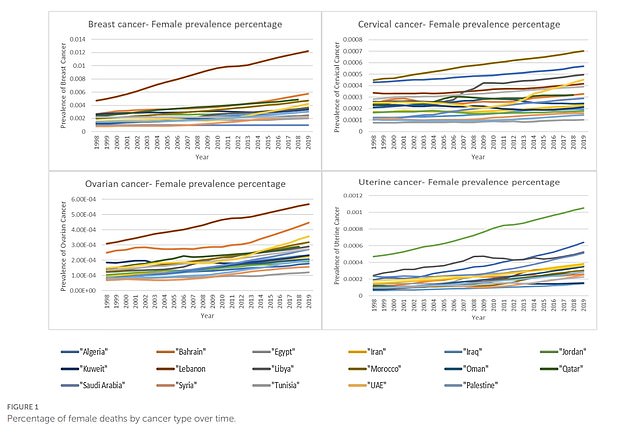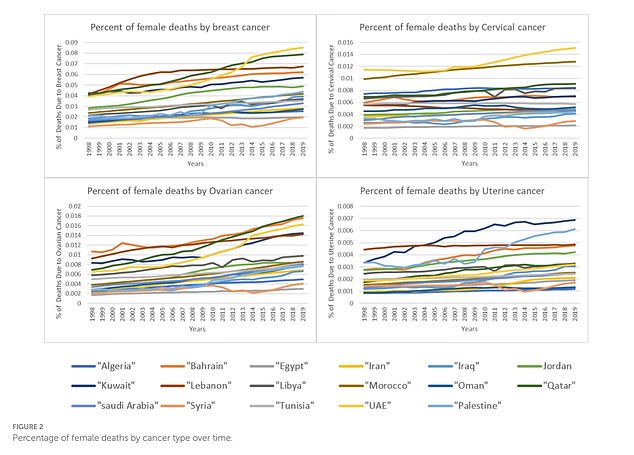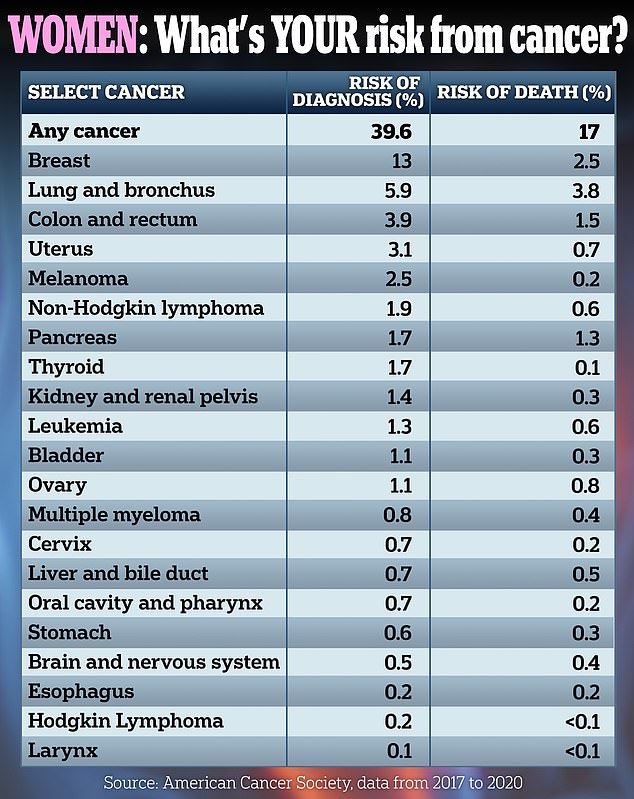-
EXPLORE FURTHER: How climate change might cut your lifespan by half a year
Global warming
might be contributing to increasing rates of
cancer
shock findings indicate for women.
Researchers in
Egypt
examined the incidence of breast, cervical, ovarian, and uterine cancers across 17 nations in the Middle East and correlated these figures with increasing temperature trends over time.
They discovered that for each one-degree Celsius rise in temperature (which equals a 1.8-degree Fahrenheit increase), instances of these four types of cancer rose by as much as 280 additional cases per 100,000 individuals during the past two decades.
The largest rise was observed in ovarian cancer cases, with an uptick of 280 per 100,000 individuals, whereas breast cancer saw the smallest surge at an addition of 173 per 100,000 people.
On average, fatalities across these four types of cancer increased by 171 to 332 deaths per 100,000 individuals with every one-degree increase in temperature. Ovarian cancer saw the most significant surge in mortality rates at 332 deaths per 100,000, whereas cervical cancer experienced the least increase at 171 deaths per 100,000.
The researchers from the American University in Cairo point out that their study was observational and does not establish causation. However, they suggest
Global warming might lead to higher levels of carcinogens, increasing exposure.
like those caused by wildfires.
Severe weather conditions like wildfires and hurricanes may also interfere with essential screenings and cancer treatments, leading to a rise in both instances of the disease and fatalities.
It is believed that women may be more susceptible to the health impacts of climate change, particularly during pregnancy and menopause.


Dr. Wafa Abuelkheir from Mataria, who is the lead author of the study and a researcher at the American University in Cairo, stated: “With increasing temperatures, there is an observed increase in cancer deaths among women, notably for ovarian and breast cancers.”
While the increments for each degree of temperature increase are small, their overall effect on public health is significant.
Although the study focused solely on nations in the Middle East and North Africa, both the United States and the United Kingdom have also experienced the impacts of climate change along with rising incidences of certain female cancers.
Each year, breast cancer affects 330,000 women in the United States, marking an annual increase of one percent since 2012, as reported by the American Cancer Society.
The incidence of uterine or endometrial cancer has risen approximately 0.6 percent annually between 2010 and 2019. Each year, this condition impacts around 69,000 women in the U.S. and leads to roughly 14,000 deaths.
Ovarian and cervical cancer rates have dropped by as much as two percent annually over the past ten years, primarily because of higher usage of contraceptives and improved availability of the human papillomavirus (HPV) vaccine.
In the UK
Every 10 minutes, another woman is diagnosed with breast cancer, totaling approximately 55,000 cases annually.
More than 12,000 women succumbed to breast cancer in 2022, with statistics indicating that this number could rise above 17,000 by mid-century.
World Health Organisation
(WHO) said.
In the UK, ovarian cancer impacts 7,500 women annually, resulting in 4,300 deaths. Uterine cancer affects 10,000 individuals each year with 2,500 fatalities. Additionally, every year sees 3,300 new cases of cervical cancer among British citizens, leading to approximately 850 deaths.
The discoveries were made following President Donald Trump’s tenure as well.
axed 1,000 climate scientists
from the Environmental Protection Agency (EPA), after a
history of rejecting climate change as a fraudulent concept
.
The research, released on Tuesday in the journal
Frontiers in Public Health
collected information about instances and fatalities related to breast, cervical, ovarian, and uterine cancers across 17 nations in the Middle East and North Africa.
The countries featured in the research encompassed Algeria, Bahrain, Egypt, Iran, Iraq, Jordan, Kuwait, Lebanon, Libya, Morocco, Oman, Qatar, Saudi Arabia, Syria, Tunisia, the United Arab Emirates, and Palestine.
Next, the team contrasted cancer statistics with shifting temperature patterns within each nation. The information gathered—from various United Nations online resources—spanned the period from 1998 to 2019.


As the temperature changes by one degree Celsius, instances of these four types of cancer rise by an additional 173 to 280 cases for every 100,000 individuals.
Ovarian cancer saw the largest rise with an extra 280 cases, whereas breast cancer showed the smallest increase with only 173 more cases.
Overall, cancer mortality rates rose by 171 to reach 332 deaths per 100,000 individuals with each increase in temperature. Ovarian cancer showed the most significant spike in fatalities, whereas cervical cancer experienced the least change.
The incidence of cancer cases and fatalities rose along with temperature levels in six nations: Qatar, Bahrain, Jordan, Saudi Arabia, the United Arab Emirates, and Syria.
In Bahrain, breast cancer incidence climbed to 330 cases per 100,000 individuals, followed by 560 in Qatar and 440 in the UAE. Regarding fatalities due to breast cancer, statistics show an increase of 420 deaths per 100,000 in Jordan, 550 per 100,000 in Qatar, 310 per 100,000 in Saudi Arabia, and 350 per 100,000 in the UAE with every rise in temperature by one degree Celsius.
The incidence of ovarian cancer rose in Bahrain, Jordan, Qatar, Saudi Arabia, and the UAE by 390, 460, 540, and 290 cases per 100,000 individuals, correspondingly, with the increase in temperature.
Mortality rates from ovarian cancer in those four countries increased to between 330 and 480 deaths per 100,000 individuals.
In Bahrain, Qatar, and Syria, cervical cancer cases rose by 380, 510, and 250 instances per 100,000 people, respectively. The number of deaths due to this illness surged by 330 per 100,000 in Iran, by 450 per 100,000 in Jordan, and dramatically climbed by 610 per 100,000 in Qatar.
For uterine cancer, the prevalence rose in Jordan, Qatar, Saudi Arabia, and the UAE to 480 per 100,000, 620 per 100,000, 360 per 100,000, and 370 per 100,000, respectively.
Uterine cancer deaths increased in Jordan and Qatar by 440 and 430 cases per 100,000 population respectively.

Dr. Sungsoo Chun, a co-author of the study and associate chair of the Institute of Global Health and Human Ecology at the American University in Cairo, stated: “An increase in temperature probably operates via various channels. It enhances contact with recognized cancer-causing agents, hinders health care services, and could also affect fundamental physiological functions within cells.”
‘Collectively, these processes might increase the likelihood of developing cancer over an extended period.’
He additionally pointed out that women are ‘biologically more susceptible to climate-linked health hazards, especially when pregnant.’
This issue is exacerbated by disparities that restrict access to medical care. Disadvantaged women encounter an increased risk since they are disproportionately affected by environmental dangers and have limited ability to obtain timely screenings and treatments,” he further stated.
Dr. Mataria warned that the study “cannot prove direct causality,” and various other elements specific to each country might also affect women’s cancer rates.
She stated: “Despite this, the strong correlations noted across various nations and forms of cancer offer robust justification for additional research.”
The group advocated for more robust cancer screening initiatives in regions highly affected by climate change, along with decreasing exposure to environmental carcinogens.
Dr. Chun stated, “Unless we tackle these fundamental weaknesses, the impact of climate change on cancer rates will keep increasing.”
Read more






